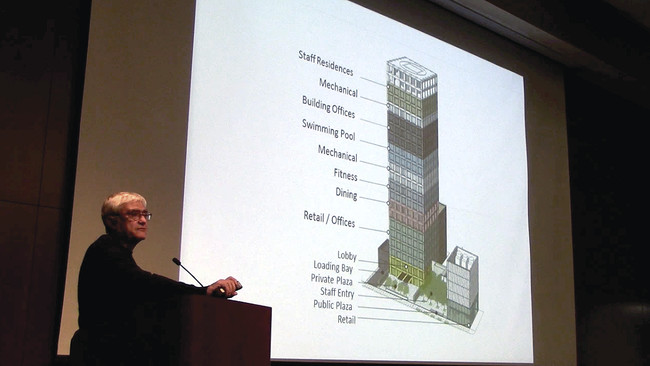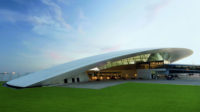
For Rafael Viñoly, running large offices in London and New York sometimes means putting out fires. Last summer, 20 Fenchurch Street, a Viñoly-designed skyscraper in the City of London, nicknamed the Walkie-Talkie, was blamed for incinerating a car—after its concave glass surface concentrated too much sunlight onto a parked Jaguar. The tabloids had a field day. Meanwhile, in New York, he may be best known for designing 432 Park Avenue, a 1,380-foot-high residential tower under construction at the corner of 57th Street. The building is one of a group of supertalls that critics have said will cast unreasonably long shadows over Central Park. On the bright side, the building, with its almost Miesian restraint, has been contrasted with an oddly fussy tower by Christian de Portzamparc a few blocks west.
How do you feel about speaking with the press?
People take everything I say wrongly. They’re probably right to take it wrongly. It’s time for some restraint, I think
Has the controversy over the Walkie-Talkie hurt you?
It’s already hurt me, or else you wouldn’t have asked the question.
So what would you like to say about the offending facade?
It wasn’t even within my range of decision-making. Our client commissioned a building that got approval, and then was sold to somebody else. And the new owner redesigned the building. So my name is on it, but it’s not my building. [In a letter to the British Architects’ Journal, the building’s new owner, Canary Wharf Group, said that "the original design needed certain modifications to make it workable."]
So will 432 Park Avenue help your reputation?
I would like to think that it doesn’t need help.
But you’re happy with how the building is turning out?
We're absolutely delighted with it. There's not too much gizmology?
Gizmology?
In the constellation of new forms, it’s surprisingly calm. The windows are simply gigantic panes of glass, set into the grid, which is also the structure. I like the fact that the grid is not just a façade, it’s not just the structure; it’s how the building works. Architecture has gone through a very whimsical phase. But I think rigor is also a very important mantra.
How did the design come about?
It’s a structural solution that is totally connected to the market. The odds that people paying this kind of money are going to like the model apartment are about one in a thousand. With this design, there is no structure in the body of the plan, only in the perimeter and the core. That gives owners the flexibility to build their own apartments, without interrupting structure or services.
The New York condo market is super-hot. Were the developers buying your name as much as your design?
I don’t consider myself a branding architect.
But there are other firms involved, including SLCE, which is listed on the building's website as executive architect, and Deborah Berke Partners and Bentel & Bentel, who are listed under "interior design," and even Handel Architects LLP, listed as "master planner." Does that mean you were only involved in the conceptual phase?
Not at all. We have tried to maintain control over the whole process. The problem is, in the profession we have accepted the notion that there is a design architect and somebody else. People assume that you’re responsible for parts of it, when you ultimately ought to be responsible for the whole thing. I find that completely alien to my training. It's like being a sculptor, but not wanting to touch the medium.
That sounds like a problem.
It’s a crisis for the profession. In the last 20 years, people have come into the field without knowing what construction is. In architecture, construction is the medium. I’ve been in this business for 45 years. I’ve been building since I was 18. I’ve done rebar drawings.
You've been working in London and New York. How do they compare?
In New York, you’re given an envelope. And as long as you are within that envelope, you can build. That’s what 432 Park Avenue is—as-of-right. But buildings have surface qualities, volumetric differences; there needs to be a design dialogue.
And in London?
The opposite is true; you don’t know what you can build. There's no as-of-right, so you prepare something, and you get bounced back and forth. It’s a highly discursive process. You talk a lot. Sometimes you hear things that are well thought-out. If you happen to be talking to somebody like Peter [Wynne Rees, the longtime planner for the City of London], somebody who understands design, it is an exciting proposition. But sometimes you hear things that are completely idiotic. And the process can take six or eight years, which distort the economics of the project. In New York, with ULURP [the Unified Land Use Review Procedure], there’s a timetable.
Which system is better?
Neither is completely right. They’re two extremes. In both cities, the planning process needs to be reinvented. In New York, you need a qualitative design review, and in London, you need some form of basic right over the land that is not subjected only to opinion.
What else are you doing in the U.S.?
Well, we completed Novartis [an office for the pharmaceutical manufacturer in New Jersey]. It is the best building I’ve done in many years. The spaces are fantastic. The way it's stepped and ramped, you can climb six floors and never notice; it's all accessible. The client is extraordinarily advanced; they have a full department that analyzes productivity based on space layout. And we're working on Rockefeller University [on the Upper East Side of Manhattan]. It's a replanning of the overall campus, an extension of the gardens and a large laboratory building. It offers a humongous amount of benefits to the public. I think people will love it.
And in the U.K.?
We're doing a very interesting project, for Manchester City, the football club. It's a training facility, with a mini-stadium, very high-end. And we're doing a complex of two or three buildings, mixed-use, in the Marble Arch section of London.
You've also been involved in the conversion of the old Battersea Power Station since 2007. But now it looks like other architects have been brought in to design the buildings.
I got the master plan approved. The disappointment is that we’re not doing any of the architecture. A lot of people are working on it: Gehry, Foster, Chris Wilkinson, Ian Simpson.
Why not you?
I don’t know why. I don’t understand it, but I’m sure I will someday.
You mentioned Foster and Gehry. Do you see yourself as part of a cadre of high-flying starchitects?
Well, I don’t have a stylistic identity. I think that approach is past. There are so many great younger architects who don’t have a particular formal trick, and I think that’s very promising.
There's been a lot of talk this year about the problems facing women in the profession. As a leading male architect, do you think there should be more women in the profession?
We have lots of women here. If you ask me, there should be more architects in the profession.



Post a comment to this article
Report Abusive Comment